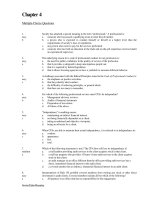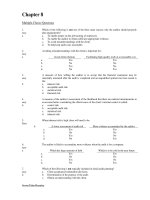Lecture Auditing and assurance services (Second international edition) Chapter 14 Auditing financinginvesting process
Bạn đang xem bản rút gọn của tài liệu. Xem và tải ngay bản đầy đủ của tài liệu tại đây (1.85 MB, 29 trang )
Chapter Fourteen
Auditing the
Financing/Investing
Process:
Prepaid Expenses;
Intangible
Assets and
Goodwill; and
Property, Plant and
Equipment
© The McGraw-Hill Companies 2010
Auditing Prepaid Expenses
Other assets that provide economic benefit
for less than a year are classified as current
assets. Prepaid expenses are a common
other asset. Examples include:
1. Prepaid insurance.
2. Prepaid rent.
3. Prepaid interest.
Insurance
Policy
© The McGraw-Hill Companies 2010
Inherent Risk Assessment –
Prepaid Expenses
The inherent risk associated with prepaid
expenses is generally assessed as low
because the accounts do not involve any
complex or contentious accounting issues.
© The McGraw-Hill Companies 2010
Control Risk Assessment –
Prepaid Expenses
Because prepaid expenses are normally
processed through the purchasing process,
control activities in purchasing should ensure that
each item is properly authorized and recorded.
© The McGraw-Hill Companies 2010
Substantive Procedures –
Prepaid Insurance
Tests of Details of the Prepaid Insurance Account
Audit testing begins by obtaining a detail
schedule of the prepaid insurance account.
Existence and
Completeness
Confirm policy
with
insurance broker,
examine
supporting
source
documents.
Rights and
Obligations
Confirm policy
beneficiary with
the insurance broker.
Valuation
Determine
unexpired portion
of policy and
insurance expense.
Classification
Determine propriety of distribution between
manufacturing overhead and SG&A
expense.
© The McGraw-Hill Companies 2010
Auditing Intangible Assets and Goodwill
Intangible assets are identifiable assets that provide
economic benefit for longer than a year, but lack physical
substance (IFRS), for example:
1. Marketing – trademark, brand name, and Internet domain names.
2.Customer – customer lists, order backlogs, and customer
relationships.
3. Artistic – items protected by copyright.
4. Contract – licenses, franchises, and broadcast rights.
5. Technology – patented and unpatented technology.
Goodwill represents the difference between the
acquisition price for a company and the fair value of the
identifiable tangible and intangible assets and liabilities
(IFRS).
© The McGraw-Hill Companies 2010
Inherent Risk Assessment –
Intangible Assets and Goodwill
The inherent risk associated with intangible
assets and goodwill raises serious risk
considerations. The accounting rules are
complex and the transactions are difficult to
audit.
Accounting standards require different asset
impairment tests for different classes of
intangible assets.
With the judgement and complexity
associated with valuation and estimation of
intangible assets and goodwill, the auditor would
likely assess the inherent risk as high.
© The McGraw-Hill Companies 2010
Control Risk Assessment –
Intangible Assets and Goodwill
In assessing control risk, the auditor considers factors
such as:
1. The expertise and experience of those determining the fair value of
the assets.
2. Controls over the process used to determine fair value
measurements, including controls over data and segregation of
duties between those committing the client to the purchase and
those undertaking the valuation.
3. The extent to which the entity engages or employs valuation
experts.
4. The significant management assumptions used in determining fair
value.
5. The integrity of change controls and security procedures for
valuation models and relevant information systems, including
approval processes
© The McGraw-Hill Companies 2010
Substantive Procedures –
Intangible Assets and Goodwill
Tests of Details of Intangible Assets and Goodwill
Tests of details associated with valuation and impairment of
intangible assets and goodwill are often necessary because the
complexity and degree of judgement increase the risk of
material misstatement. Some substantive evidence is required
for all significant accounts, and, as noted above, substantive
analytical procedures are not likely to provide sufficient,
appropriate evidence for significant transactions involving
intangible assets and goodwill. Four assertions are normally
considered for tests of details of intangible assets:
1. Existence and completeness.
2. Valuation.
3. Rights and obligations.
4. Classification.
© The McGraw-Hill Companies 2010
Auditing the Property Management
Process
Property, plant and equipment usually represents
a material amount in the financial statements.
Recurring Engagement
New Engagement
The auditor is able to focus
on additions and retirements
in the current period because
amounts from prior periods
havebeen subject to audit
procedures.
the auditor has to verify the
assets that make up the
beginning balance in
property, plant and
equipment.
© The McGraw-Hill Companies 2010
Property Management Process at
EarthWear Clothiers
Physical Plant
IT Department
From
purchasing
process
Specialized
PP&E
transactions
PP&E
transaction
file
PP&E
program
Input
Review for
proper
recording
Reconcile to
general ledger
PP&E
master
file
PP&E
transaction
report
Monthly PP&E
subledger
© The McGraw-Hill Companies 2010
General
ledger
master file
General
ledger
program
General
ledger
report
Types of Transactions
Four types of PP&E transactions may occur:
1. Acquisition of capital assets for cash or other
non-monetary considerations.
2. Disposition of capital assets through sale,
exchange, retirement or abandonment.
3. Depreciation of capital assets over their useful
economic life.
4. Leasing of capital assets.
© The McGraw-Hill Companies 2010
Inherent Risk Assessment –
Property Management Process
There are three inherent risk factors that must
be considered by the auditor.
Complex
accounting
issues.
Difficult-to-audit
transactions.
© The McGraw-Hill Companies 2010
Misstatements
detected in
prior audits.
Inherent Risk Assessment –
Property Management Process
Complex Accounting Issues
Lease accounting, self-constructed assets and
interest capitalization are vivid examples of some
of the complex accounting issues faced by
auditors.
© The McGraw-Hill Companies 2010
Inherent Risk Assessment –
Property Management Process
Difficult-to-Audit Transactions
When assets are purchased directly from a
vendor, the transaction is relatively easy to
audit. However, transactions involving donated
assets, non-monetary exchanges, and selfconstructed assets are more difficult to audit.
© The McGraw-Hill Companies 2010
Inherent Risk Assessment –
Property Management Process
Misstatements Detected in Prior Audits
If misstatements in prior audits have been
detected, the auditor should set inherent risk
higher than if few or no misstatements have
been found in the past.
© The McGraw-Hill Companies 2010
Control Risk Assessment –
Property Management Process
Occurrence and Authorization
Control procedures for the occurrence and
authorization of property, plant and equipment
are normally part of the purchasing process.
However, large capital asset transactions may
be subject to additional controls. Companies
should have an authorization table for approving
capital asset transactions.
© The McGraw-Hill Companies 2010
Control Risk Assessment –
Property Management Process
Completeness
© The McGraw-Hill Companies 2010
Control Risk Assessment –
Property Management Process
Key Segregation of Duties and Possible Errors
© The McGraw-Hill Companies 2010
Substantive Analytical Procedures –
Property, Plant and Equipment
© The McGraw-Hill Companies 2010
Tests of Details of Transactions and Account
Balances and Disclosures
Completeness and Accuracy
The auditor begins the process by obtaining a
lead schedule and detailed schedules of
additions and dispositions of assets. These
schedules are footed and agreed to the general
ledger. The auditor can trace a sample of assets
to the property, plant, and equipment subsidiary
ledger.
© The McGraw-Hill Companies 2010
Tests of Details of Transactions and
Account Balances and Disclosures
Cut-off
Cut-off is normally part of the accounts payable
and accrued expenses work. Vendor’s invoices
from a few days before and after year end are
examined to determine if the assets is recorded
in the proper accounting period.
© The McGraw-Hill Companies 2010
Tests of Details of Transactions and
Account Balances and Disclosures
Classification
First, the auditor must determine that the capital
asset is recorded in the proper account. Second,
the repairs and maintenance account should be
reviewed to determine if any capital assets have
been incorrectly recorded in these accounts.
Finally, each material lease agreement should be
reviewed for proper classification as operating or
capital lease.
© The McGraw-Hill Companies 2010
Tests of Details of Transactions and
Account Balances and Disclosures
Existence
A list of all major additions should be obtained
and each addition should be vouched to
supporting documentation. For major
acquisitions, the auditor may physically
examine the capital asset. This is often done
during the inventory observation. Major
dispositions should be vouched to supporting
documentation and examined for proper
authorization.
© The McGraw-Hill Companies 2010
Tests of Details of Transactions and
Account Balances and Disclosures
Rights and Obligations
In most cases, rights or ownership can be
determined by examining vendor’s invoices and
other supporting documents. In some cases the
auditor may wish to confirm property deeds or
title documentation.
© The McGraw-Hill Companies 2010









